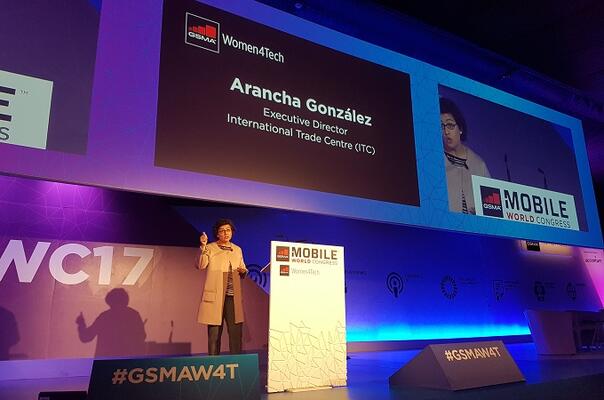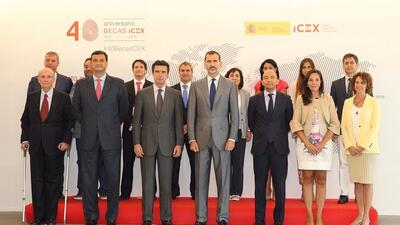
Keynote Speech by ITC Executive Director at Women4Tech Summit (en)
ARANCHA GONZÁLEZ
EXECUTIVE DIRECTOR
MOBILE WORLD CONGRESS 2017
BARCELONA, SPAIN
2ND MARCH 2017
The fourth industrial revolution is premised on connectivity and digital inclusion. And the only way for this to be successful and inclusive is by anchoring this within women’s economic empowerment.
“Living and walking inspiration” – that is how I would describe the women in business who have presented today because they continue to live their business dreams in the tech industry despite the sometimes enormous odds stacked against them. The economy is going digital, innovation underpins competitiveness. Yet, despite tremendous opportunities, the gender imbalance in the technology sector is persistent. It is hard to believe that as we embark into this fourth industrial revolution only 3% of tech CEOs are women, or that women account for under 20% of ICT specialists globally or that only 15% of start-ups have a female founder – just see for yourselves literally down the road at “4 Years From Now” (4YFN) how many young women are there as exhibitors.
I head the International Trade Centre (ITC), which is the joint agency of the United Nations and the World Trade Organization. We are about “doing business while doing good”. ITC supports thousands of living and walking inspirations from the developing world – both in and out of the tech industry to be competitive in the marketplace. Having worked in multiple value chains, goods and services industries, with different economic actors and governments – there are many lessons we have learned along the way.
Firstly, we know that all business start-ups face challenges. Even after real-life business issues like day-to-day business operations and product development are fixed, women in business in particular still face unique business support and business environment challenges including low visibility in the marketplace; limited access to government and corporate procurement opportunities; and de facto exclusion from investor and other key business development and business generation networks. In fact, ITC research shows that only 1 in 5 surveyed firms that trade are owned and operated by a woman.
Secondly, “no man – or woman, as the case may be, is an island. Smart partnerships are not just a cliché – they matter if we actually want to raise the level of women in tech since the gender gaps exist throughout the entire value chain; starting with girls being five times less likely to consider a technology-related career despite using computers and the internet just as much as teenage boys.
At ITC, our partnerships with companies like Google, eBay and Brazil’s CI&T and Switzerland’s Seedstars; and with countries like the United Kingdom, Finland, Australia and the Netherlands; as well as with organizations like UN Women and the International Telecommunications Union has played a crucial role in our success at bringing women in tech to market. Thanks to these various types of collaboration, ITC has been training, mentoring and building the skill set of women-owned start-ups like Shopfront’s Siffat Sarwar in Bangladesh; improving the branding and marketing of firms like Elizabeth Ntege’s NFT Consult to get them market-ready; and linking women like DataScience’s Linet Kwamboka from Kenya to other companies keen to do business.
Thirdly, it actually makes a difference whether you back a women-owned business as opposed to a male-owned business. I am not just saying this because I am a woman myself. I am saying this because Mckinsey, Credit Suisse, the World Bank and several others have studied the socio-economic benefits of economically empowering women and have all found that there is a positive impact emerging when women experience expanding economic opportunities. They go on to reinvest in education, health and other related poverty-reducing priorities at a rate of 90% compared to men who only do so at a rate of 40%. It is also significant if we consider that women who experience expanding economic opportunities more often than not go on to empower other women who then help to repeat and reinforce the poverty-reducing results.
As far as the UN Sustainable Development Agenda and the goal to eradicate extreme poverty by 2030 goes – this is a very big deal. Essentially, the more we invest in and support and promote women in business is the more likely we will have better educated children; better health benefits and lower incidences of poverty. In essence, more inclusive trade-led development.
With ITC support, women in tech like Farhana Rahman, brought her own software development company – UY Systems Limited – in Bangladesh to the next level, now employing more than 75 people, including 28 women. Her story showcases my earlier point about the benefits of economically empowering women. Farhana dedicated a lot of her time to promoting the development of women entrepreneurship in Bangladesh. She is an active member of the Asia Foundation, the driving force behind the Women’s Forum of the national IT association BASIS and has mentored women entrepreneurs and freelancers in the IT sector and has pioneered an online healthcare portal that over 130 Bangladeshi businesswomen now use to promote and sell their services.
Many of us have a Farhani or future Farhanis in our midst. So the big question for us is ‘how can we support them and help them grow in the tech industry’?
Here, we need coherent policies, encouragement of women and girls in STEM, breaking stereotypes, training and mentoring, raising awareness about IT career options through on - and offline outreach events, business case competitions and media work. Across the world, the number of women joining the information and communication technology (ICT) industry is low. This is even true in the most innovative and dynamic companies. Just last week we heard from UBER CEO Travis Kalanick that of his employees working as engineers, product managers or data scientists, only 15% are women and that at Facebook it is 17%, Google it is 18% and Twitter is only 10%. Often this is down to simple things such as encouraging women to enter the sector, to more complex actions like changing laws and developing more coherent policies to buck this trend.
Take Bangladesh, for example, where ICT is a fast-growing sector comprising more than 200,000 professionals. However, in a country where over 50% of the population is female, the lack of women IT professionals is notable: only 13% of the IT workforce is women. And only 1% of ICT companies are led by women. Social barriers — including stereotypes and gender bias in colleges and universities — continue to block women’s progress in the IT sector
To move the needle on this issue, I suggest that as buyers and investors in the marketplace you give better consideration to women in tech.
Closing the gender gap in the tech industry depends a lot on bringing greater visibility to women-led ideas and start-ups to consumers and investor networks – both face-to-face and virtual networks like SLUSH, East AfricaCom and EQUALS.com. Women entrepreneurs often lack access to market information as traditional business networks are often male-dominated. One way to bridge this divide is by creating new channels for women entrepreneurs to connect to each other.
Data-enabled mobile phones can connect women-owned firms to customers abroad by integrating women-led businesses into the global marketplace. Platforms such as eBay and Etsy enable home-based businesses to export across the world – by the way, Siffat’s Shopfront app, which I mentioned a little earlier, is also working in this space. Moreover, online stores have lower operating costs and higher profit margins than traditional small-scale brick-and-mortar retail shops.
ITC is also actively supporting to get women to trade online. We launched SheTrades.com, a web- and mobile-based application to help women entrepreneurs find business partners, promote their businesses and meet new customers. Our platform also provides learning solutions to help them grow their businesses. So far, we have been able to connect over 800,000 women entrepreneurs. The next step is to ensure that these initiatives gain traction so that women-owned businesses become more integrated into global supply chains. I invite you to join us in this initiative – and you can start by downloading the app from Google Play (the iOS version is coming soon – help us get it out even sooner).
To make this possible and increase impact exponentially, there needs to
be more investment in women, including BY women.
Access to finance is one of the most significant challenges facing women entrepreneurs. For instance, a recent study on entrepreneurship in the US shows that women-owned small businesses received a mere 4% of total loans disbursed, despite the estimate that women entrepreneurs bring in 20% more revenue with 50% less money invested. In the US only 7% of investor money goes to women-led startups; per every investment given to a woman-led start up, 6 are given to all-male teams. These are the sad facts.
Another way to support women-owned start-ups in tech is by increasing the number of women venture capitalists. Women account for only 4% of venture capitalists. The barriers to accessing finance facing women entrepreneurs also have to do with the shortage of women investors. Studies show that women investors are more likely to invest in women-owned businesses. Increasing the number of women venture capitalists can increase the share of women-owned tech start-ups, help them grow faster and capture a larger market share. This means that financing women entrepreneurs not only empowers women, it is good business.
With global trade slowing, the case is more and more compelling for us to activate untapped resources and underutilized opportunities. Women and tech and women in tech are critical engines of growth which are well positioned to stimulate economic growth and poverty reducing effects. I encourage you to find your niche in improving the engagement and success of women in tech. Remember; women are the secret weapon in this fourth industrial revolution. Invest in them. Ignite them. Empower them.
Thank you









